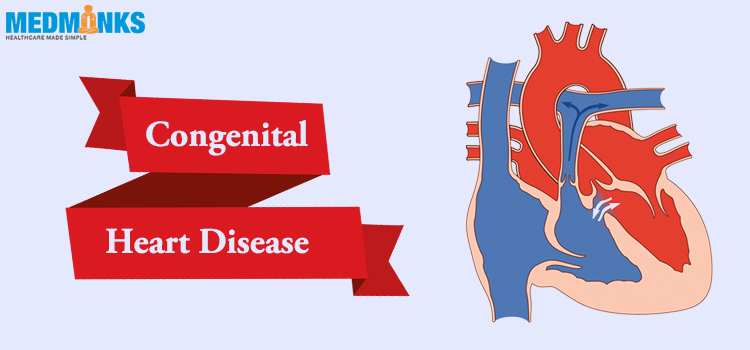Congenital Heart Disease

There are millions of people in the world who are born with Congenital Heart Disease, a defect in their hearts. The USA’s Centers for Disease Control and Prevention has reported that there are over 1 million children and 1 million adults in the USA alone who are suffering from Congenital Heart Disease. Advances in diagnosis have drastically helped in improving the treatment in the past decade, allowing children with these heart defects to survive into their adulthood. However, in some cases, the patient might require to take continuous care of their heart defect for their entire life.
What happens in a Congenital Heart Disease?
Congenital Heart Disease is a defect or abnormality present in the heart from birth. The fault might affect the blood vessels, valves, walls of the heart.
Type of Congenital Heart Disease
Congenital Heart can cause a defect in the following parts of the heart:
Heart Valves
There are four valves in the heart that allow blood to flow in a particular direction. A defect in these valves can cause the blood to leak or block in the heart, which can tamper with the heart's ability to pump adequately.
Heart Walls
A defect in the heart walls prevents the walls from developing correctly which exist between the lower and upper chamber and the left and right sides of the heart, causing the blood to flow back inside the heart, or creating a buildup that might cause blood clots. Heart wall defects force the heart to work under high pressure that can lead to high blood pressure.
Blood Vessels
Arteries and veins responsible for carrying blood into the heart and the body are affected by Congenital Heart Disease present in the blood vessels, that disables them to function correctly, which can reduce blood flow causing several health complications for the patient.
Cyanotic & Acyanotic
Congenital Heart Disease is classified into two types, cyanotic and acyanotic; both conditions prevent the blood from pumping correctly into the body. However, the main difference in the two conditions is that cyanotic heart disease reduces the oxygen level in the blood, whereas acyanotic heart disease doesn’t. Babies born with reduced oxygen might find difficulty in breathing and have bluish tints on their skin.
Symptoms of Congenital Heart Disease
Recognizing Congenital Heart Disease symptoms is quite easy for this heart condition as it is present in the patient since their birth. Sometimes these symptoms can be identified instantly after the patient’s birth, and in some case, symptoms appear much later.
Also Check: Warning Signals of Heart Problems
Newborns -
- Bluish Lips, toes, skin, and fingers
- Feeding difficulties
- Chest Pain
- Delayed Growth
- Low Birth Weight
Later Years –
- Dizziness
- Fainting
- Swelling
- Trouble Breathing
- Abnormal Heart Rhythms
- Fatigue
Causes of Congenital Heart Disease
Congenital Heart Disease is caused due to initial development complexities of the heart structure. The defect interferes and hinders with the blood flow in the heart that also affects the breathing. Researchers haven’t been able to point a finger on the exact reason for the development of heart defects, but these are the following causes that were suspected in the studies:
- Family History or Genes
- Consumption of certain medications during pregnancy that interferes with the baby’s growth.
- Increased sugar levels in blood like diabetes can limit childhood growth.
- Mothers who have experienced a viral infection in the first trimester of their pregnancy can also lead to a heart defect their baby.
Congenital Heart Disease Treatment
- Heart devises Implants - A surgery can be conducted to insert devices into the heart that can help in balancing the blood flow and the rhythm of the heart beats that can help it to function correctly.
- Medications- Regular consumption of medicines orally or via IV can help in maintaining the health of the patient.
- Catheter Procedure – allows surgeons to repair Congenital Heart defects by surgically inserting a tube into the patient vein in the leg, guiding it up to their heart.
- Open Heart Surgery – is considered when a catheter procedure isn’t enough to treat the defect. This surgery is conduct to widen/narrow blood vessels, repair heart valves, and close holes present in the heart
- Heart Transplant - This is the only permanent solution to get rid of Congenital Heart Disease entirely. In this procedure, the defected heart is replaced with a healthy functioning heart.
FAQs
How can I prevent my child from suffering from Congenital Heart Disease?
Ensure to consult your doctor before eating any prescribed drug, also make regular check appointment to see the growth and health of the child.
Is Congenital Heart Disease curable?
Congenital Heart Disease can only be cured permanently via a heart transplant, but due to the weak heart structure of these patients, it is not considered as the safest option. However, the patient can survive this condition if they take regular medication and treatment care while maintaining the healthy lifestyle.
You can explore our website to learn about other heart diseases or find the best hospital for cardiac diseases in India.





